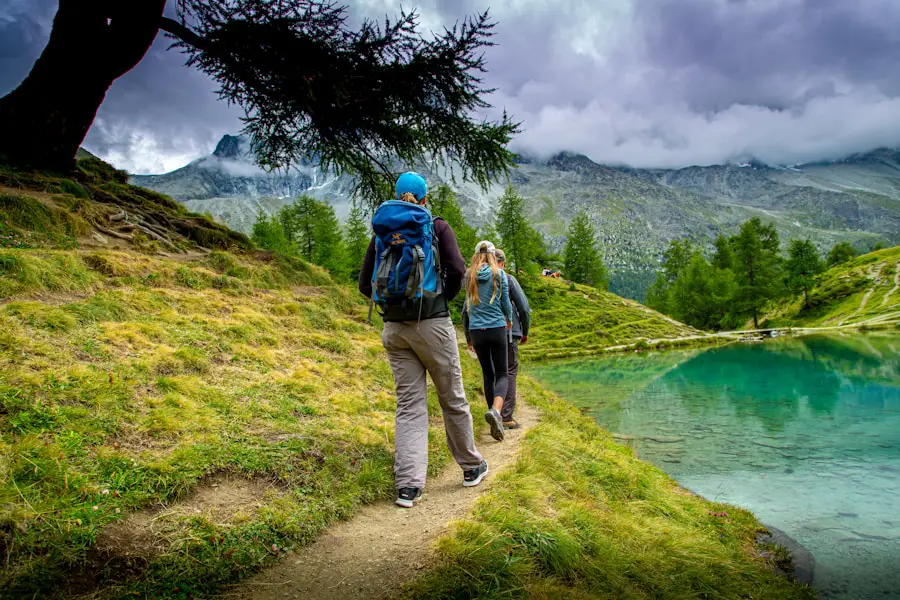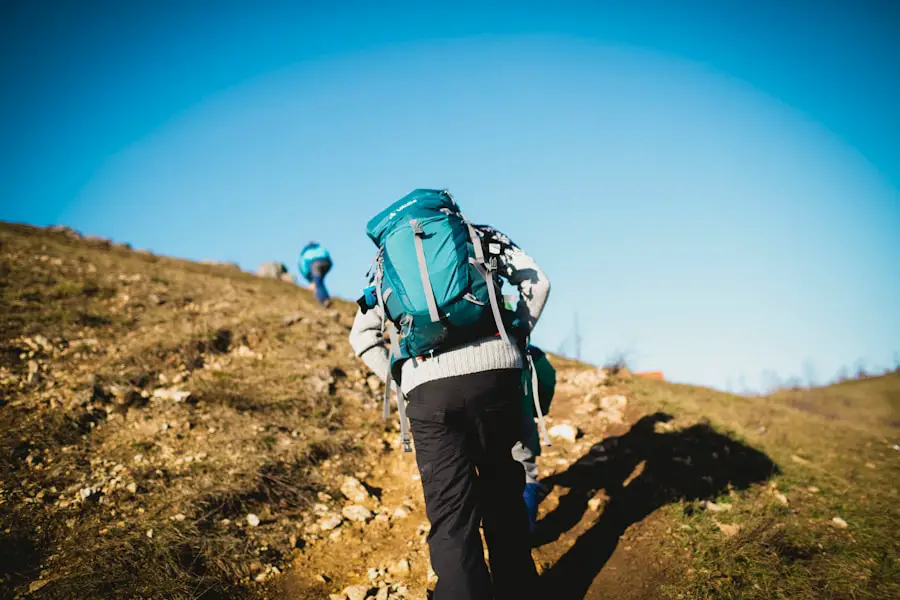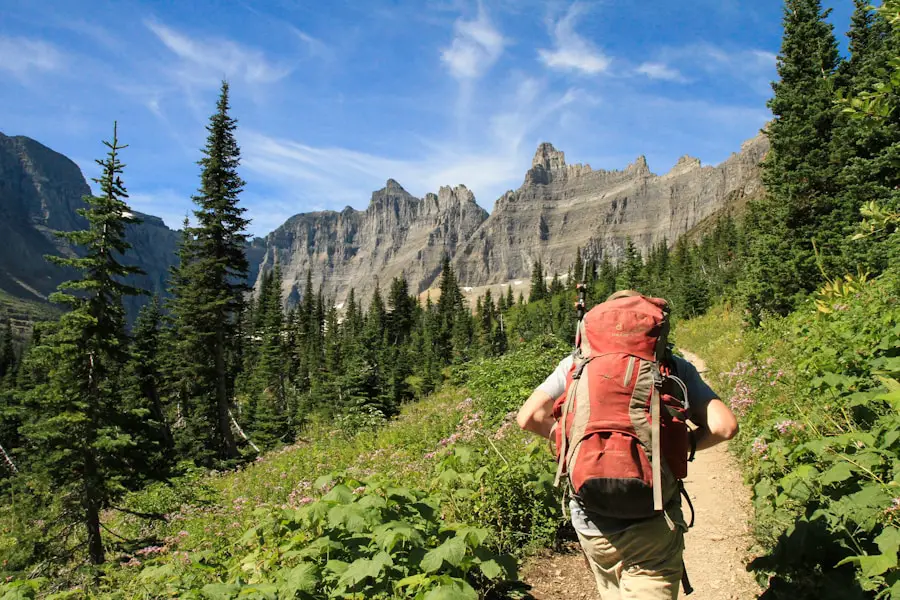Selecting the appropriate footwear is one of the most critical decisions a hiker can make. The right shoes or boots can significantly enhance comfort, stability, and overall hiking experience. When considering footwear, it is essential to evaluate the terrain you will be traversing.
For instance, if your hike involves rocky paths or steep inclines, a sturdy pair of hiking boots with good ankle support and a rugged sole is advisable. These boots are designed to provide traction and protect your feet from sharp rocks and uneven surfaces. Brands like Merrell, Salomon, and Vasque offer a range of options that cater to different hiking conditions, ensuring that you can find a pair that meets your specific needs.
In contrast, if your hike is on well-maintained trails or involves less challenging terrain, a lightweight hiking shoe or trail runner may suffice. These options are generally more breathable and flexible, allowing for greater agility and comfort over long distances. However, it is crucial to ensure that whatever footwear you choose fits well.
Ill-fitting shoes can lead to blisters, calluses, and other foot ailments that can ruin an otherwise enjoyable outing. It is advisable to try on shoes with the socks you plan to wear while hiking and to walk around in them for an extended period before making a purchase. This practice helps ensure that you select footwear that will keep your feet happy throughout your journey.
Key Takeaways
- Choose footwear that is comfortable, provides good support, and is appropriate for the terrain
- Pack essential gear such as a first aid kit, navigation tools, extra clothing, and enough food and water
- Dress for the weather by layering clothing, wearing moisture-wicking fabrics, and bringing rain gear
- Navigate with a map and compass, and familiarize yourself with the trail before setting out
- Stay hydrated and nourished by drinking water regularly and eating high-energy snacks
- Follow trail etiquette by yielding to others, staying on designated paths, and minimizing noise
- Prepare for wildlife encounters by making noise, carrying bear spray, and knowing how to react to different animals
- Know when to turn back if the weather worsens, you feel fatigued, or encounter unexpected obstacles
Packing the Essential Gear
When preparing for a hike, packing the right gear is paramount to ensure safety and enjoyment. Essential items typically include a well-fitted backpack, which should be comfortable enough to carry for extended periods without causing strain. The size of the backpack will depend on the length of your hike; day hikes may require a smaller pack, while multi-day treks necessitate larger packs with more compartments for organization.
Inside the backpack, it is vital to include items such as a first-aid kit, a multi-tool or knife, and a flashlight or headlamp with extra batteries. These tools can be invaluable in emergencies or when navigating in low-light conditions. In addition to safety gear, consider packing layers of clothing that can be added or removed as needed.
A lightweight rain jacket is also essential, as weather conditions can change rapidly in many hiking areas. Furthermore, including a portable phone charger can be beneficial for longer hikes where you may rely on your phone for navigation or emergency communication. Food and snacks are another critical component of your gear; high-energy options like trail mix, energy bars, or jerky can help maintain your energy levels throughout the hike.
By carefully selecting and packing these essential items, you can ensure that you are well-prepared for whatever challenges the trail may present.
Dressing for the Weather

Dressing appropriately for the weather is crucial for a successful hiking experience. Weather conditions can vary dramatically depending on the season and location, so it is essential to check forecasts before heading out. In colder climates, layering becomes particularly important.
Start with a moisture-wicking base layer that will keep sweat away from your skin, followed by an insulating layer such as fleece or down to retain body heat. Finally, an outer shell that is both waterproof and windproof will protect against the elements. This three-layer system allows hikers to adjust their clothing based on activity level and changing weather conditions.
Conversely, in warmer climates, lightweight and breathable fabrics are key to staying comfortable. Look for clothing made from synthetic materials or merino wool that wick moisture away from the body while allowing for airflow. A wide-brimmed hat can provide shade and protect against sunburn, while sunglasses with UV protection are essential for safeguarding your eyes from harmful rays.
Additionally, applying sunscreen to exposed skin is vital regardless of the season; UV rays can penetrate clouds and cause damage even on overcast days. By dressing appropriately for the weather, hikers can enhance their comfort and safety on the trail.
Navigating with a Map and Compass
| Navigation Technique | Accuracy | Time to Learn |
|---|---|---|
| Map and Compass | High | Medium |
While modern technology has made navigation easier with GPS devices and smartphone apps, understanding how to use a map and compass remains an invaluable skill for hikers. Maps provide detailed information about trails, elevation changes, water sources, and potential hazards in the area. Familiarizing yourself with topographic maps can help you understand the terrain better and plan your route accordingly.
When using a map, it is essential to orient it correctly by aligning it with the landscape around you; this practice ensures that you have a clear understanding of your surroundings. A compass complements map reading by providing directional guidance. To use a compass effectively, first identify your location on the map and determine your intended destination.
By taking a bearing from your current position to your destination, you can use the compass to maintain that direction while navigating through the wilderness. It is also important to account for declination—the difference between magnetic north and true north—when using a compass in different geographical areas. Practicing these skills before embarking on a hike can build confidence in navigation abilities and prepare you for unexpected situations where technology may fail.
Staying Hydrated and Nourished
Hydration is one of the most critical aspects of hiking that often gets overlooked until it’s too late. Dehydration can lead to fatigue, dizziness, and impaired judgment, making it essential to drink water regularly throughout your hike. A general guideline is to consume about half a liter of water per hour during moderate activity in moderate temperatures; however, this amount may need to be adjusted based on individual needs and environmental conditions.
Carrying a hydration reservoir or water bottles in your backpack ensures easy access to water while on the move. In addition to hydration, maintaining energy levels through proper nutrition is equally important during hikes. Consuming high-energy snacks such as nuts, dried fruits, granola bars, or energy gels can provide quick fuel when needed.
It’s beneficial to pack a variety of snacks to avoid monotony and keep morale high during long treks. For longer hikes or multi-day trips, consider preparing lightweight meals that are easy to cook and pack but still provide adequate nutrition. Dehydrated meals are popular among backpackers due to their convenience and lightweight nature; simply add hot water to rehydrate them at meal times.
By prioritizing hydration and nutrition, hikers can sustain their energy levels and enjoy their outdoor adventures more fully.
Understanding Trail Etiquette

Trail etiquette is an essential aspect of hiking that promotes safety and respect among outdoor enthusiasts. Understanding these unwritten rules helps maintain harmony on shared trails and ensures that everyone has an enjoyable experience. One fundamental principle is yielding the right of way: hikers traveling uphill generally have the right of way over those descending.
This practice allows those climbing to maintain their momentum without interruption while providing descending hikers an opportunity to step aside safely. Another important aspect of trail etiquette involves noise levels and wildlife interactions. Keeping noise to a minimum allows others to enjoy the tranquility of nature while also minimizing disturbances to wildlife habitats.
Additionally, when encountering animals on the trail—such as deer or bears—maintaining a safe distance is crucial for both your safety and theirs. It’s also important to adhere to Leave No Trace principles by packing out all trash and minimizing your impact on the environment. By practicing good trail etiquette, hikers contribute positively to the outdoor community and help preserve natural spaces for future generations.
Preparing for Wildlife Encounters
Encounters with wildlife are one of the most thrilling aspects of hiking but also come with inherent risks that require preparation and caution. Understanding which animals inhabit the area you plan to hike in is crucial; this knowledge allows you to take appropriate precautions based on potential encounters with species such as bears, snakes, or moose. For instance, if hiking in bear country, carrying bear spray and knowing how to use it effectively can be life-saving in an emergency situation.
When hiking in areas known for wildlife activity, it’s essential to make noise while walking—this alerts animals to your presence and reduces the likelihood of surprising them unexpectedly. Additionally, learning how to react during an encounter is vital; remaining calm and backing away slowly without turning your back on the animal is often recommended when faced with larger wildlife like bears or moose. Educating yourself about local wildlife behavior can help mitigate risks associated with encounters while allowing you to appreciate these magnificent creatures from a safe distance.
Knowing When to Turn Back
One of the most challenging decisions hikers face is knowing when to turn back during a trek. Factors such as time constraints, weather changes, physical exhaustion, or injury should all be considered when evaluating whether to continue or retreat. It’s essential to have a clear understanding of your limits before embarking on any hike; this self-awareness allows you to make informed decisions about your safety throughout the journey.
Additionally, being aware of environmental conditions is crucial; sudden changes in weather can create hazardous situations such as flash floods or lightning storms that necessitate immediate action. If you find yourself lost or disoriented despite having navigational tools at hand, it may be wiser to retrace your steps rather than risk further complications by continuing on an uncertain path. Ultimately, prioritizing safety over reaching a destination ensures that you can enjoy future hikes without compromising your well-being in challenging situations.
If you’re planning a hiking trip, it’s important to be prepared with the 10 essentials of hiking.
These items are crucial for a safe and enjoyable outdoor adventure. For more tips on essential travel gear, check out this article on the best travel camera backpacks. Having the right backpack can make a big difference in how comfortable and organized you are while on the go.Love travel? Join Our Facebook Community For More Tips.
FAQs
What are the 10 essentials of hiking?
The 10 essentials of hiking are a list of items that are recommended to bring on every hike to ensure safety and preparedness in the outdoors.
Why are the 10 essentials important?
The 10 essentials are important because they can help hikers be prepared for unexpected situations, stay safe, and potentially save lives in the wilderness.
What are the 10 essential items for hiking?
The 10 essential items for hiking are navigation tools, sun protection, insulation, illumination, first-aid supplies, fire, repair kit and tools, nutrition, hydration, and emergency shelter.
What are navigation tools for hiking?
Navigation tools for hiking include a map, compass, GPS device, and the knowledge of how to use them to navigate the trail.
What is included in sun protection for hiking?
Sun protection for hiking includes sunscreen, sunglasses, and a hat to protect the skin and eyes from harmful UV rays.
What is insulation in the context of hiking?
Insulation in hiking refers to extra clothing layers such as a jacket, hat, and gloves to stay warm in changing weather conditions.
What is illumination for hiking?
Illumination for hiking includes a headlamp or flashlight with extra batteries to provide light in case of unexpected darkness or emergencies.
What are first-aid supplies for hiking?
First-aid supplies for hiking include bandages, gauze, adhesive tape, antiseptic wipes, pain relievers, and any personal medications.
What is a fire starter in the context of hiking?
A fire starter for hiking can include waterproof matches, a lighter, or a fire starter tool to build a fire for warmth, cooking, or signaling for help.
What is a repair kit and tools for hiking?
A repair kit and tools for hiking can include a multi-tool, knife, duct tape, and any specific gear repair items needed for the hike.
What is included in nutrition and hydration for hiking?
Nutrition and hydration for hiking include high-energy snacks, food, and plenty of water or a way to purify water from natural sources.
What is emergency shelter for hiking?
Emergency shelter for hiking can include a lightweight tarp, space blanket, or bivy sack to provide protection from the elements in case of an unexpected overnight stay.
